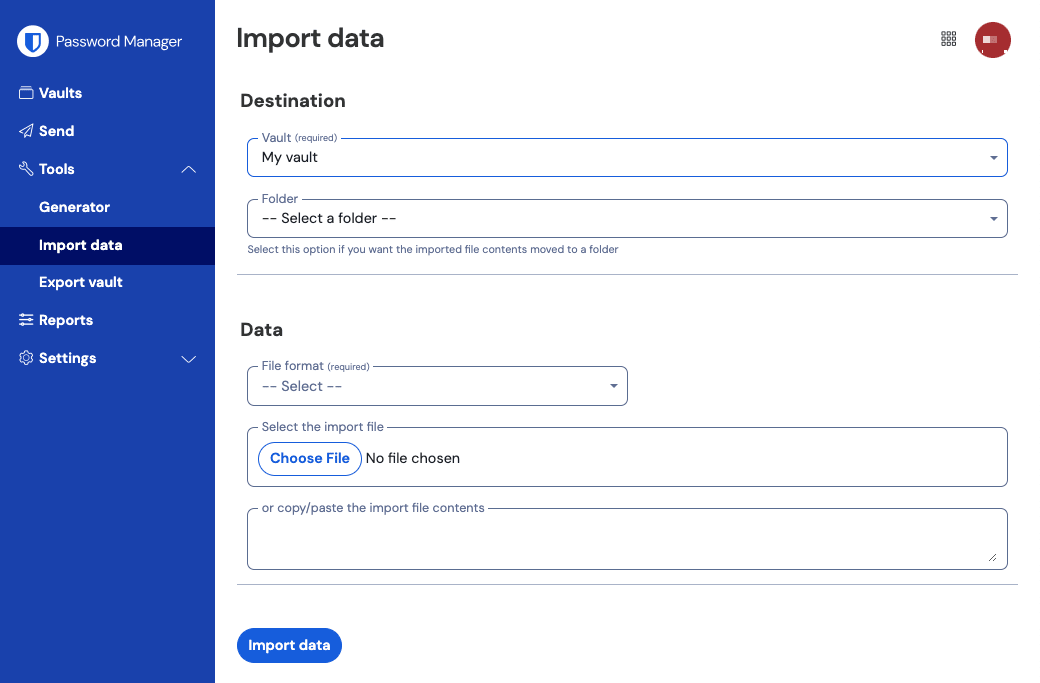Import Data from Myki
Use this article for help exporting data from Myki and importing into Bitwarden. Myki data exports are available as .csv files.
The process for exporting data from Myki is different depending on which platform you are using. Whenever possible, we recommend exporting from the Myki web app for the smoothest experience importing to Bitwarden.
For help exporting from Myki, refer to these Myki articles.
If you exported from a Myki mobile app, you will be required to condition your .csv files for import into Bitwarden. This will primarily involve renaming column headers and, in some cases, re-ordering columns in the .csv.
Each of the following sections will document first the format exported by Myki and second the format expected by Bitwarden.
UserAccount.csv
Exported:
BashNickname,Url,Username,Password,Additional Info,Two Factor Secret,Status
Expected:
Bashnickname,url,username,password,additionalInfo,twofaSecret,status,tags
CreditCard.csv
Exported:
BashNickname,Card Number,CardName,Exp Month,Exp Year,CVV,Additional Info,Status
Expected:
Bashnickname,status,tags,cardNumber,cardName,exp_month,exp_year,cvv,additionalInfo
IdCard.csv
Exported:
BashNickname,Id Type,Id Number,Id Name,Id Issuance Date,Id Expiration Date,Id Country,Additional Info,Status
Expected:
Bashnickname,status,tags,idType,idNumber,idName,idIssuanceDate,idExpirationDate,idCountry,additionalInfo
Address.csv
Exported:
BashNickname,First Name,Middle Name,Last Name,Email,First Address Line,Second Address Line,Title,Gender,Number,City,Country,Zip Code,Additional Info,Status
Expected:
Bashnickname,status,tags,firstName,middleName,lastName,email,firstAddressLine,secondAddressLine,title,gender,number,city,country,zipCode,additionalInfo
Note.csv
Exported:
BashTitle,Content,Status
Expected:
Bashnickname,status,content
User2FA.csv
Exported:
BashNickname,Additional Info,Two Factor Secret,Status
Expected:
Bashnickname,status,tags,authToken,additionalInfo
Data can be imported to Bitwarden from the web vault, CLI, desktop app, or browser extension. Data is encrypted locally before being sent to the server for storage.
To import data to your vault:
Log in to the web vault at https://vault.bitwarden.com, https://vault.bitwarden.eu, or
https://your.bitwarden.domain.comif self-hosting.Select Tools → Import data from the navigation:

Import data Complete the following fields from the drop down menus:
Vault: Select the import destination such as your individual vault or an organizational vault that you have access to.
Folder or Collection: Select if you would like the imported content moved to a specific folder or organization collection that you have access to.
File format: Select the import file format.
Select Choose File and add the file to import or copy/paste the contents of your file into the input box.
warning
Importing does not check whether items in the file to import already exist in your vault. If you import multiple files or import files with items already in your vault, this will create duplicates.
Select Import data to trigger the import. If you are importing a password protected
.jsonfile, enter the password into the Confirm vault import window that will appear.After successful import, delete the import source file from your computer. This will protect you in the event your computer is compromised.
Additional items such as file attachments, Sends, and trash will need to be manually uploaded to your vault.
To import data to your vault:
In the Settings tab, select Vault and choose the Import items option.
Complete the following fields from the drop down menus:
Vault: Select the import destination such as your individual vault or an organizational vault that you have access to.
Folder or Collection: Select if you would like the imported content moved to a specific folder or organization collection that you have access to.
File format: Select the import file format.
Select Choose File and add the file to import or copy/paste the contents of your file into the input box.
warning
Importing does not check whether items in the file to import already exist in your vault. If you import multiple files or import files with items already in your vault, this will create duplicates.
Select Import Data to trigger the import. If you are importing a password protected
.jsonfile, enter the password into the Confirm Vault Import window that will appear.After successful import, delete the import source file from your computer. This will protect you in the event your computer is compromised.
To import data to your vault:
Select File > Import data.
Complete the following fields from the drop down menus:
Import destination: Select the import destination such as your individual vault or an organizational vault that you have access to.
Folder or Collection: Select if you would like the imported content moved to a specific folder or organization collection that you have access to.
File format: Select the import file format.
Select Choose File and add the file to import or copy/paste the contents of your file into the input box.
warning
Importing does not check whether items in the file to import already exist in your vault. If you import multiple files or import files with items already in your vault, this will create duplicates.
Select Import Data to trigger the import. If you are importing a password protected
.jsonfile, enter the password into the Confirm Vault Import window that will appear.After successful import, delete the import source file from your computer. This will protect you in the event your computer is compromised.
To import data to your vault from the CLI, use the following command:
Bashbw import <format> <path>bw import requires a format (use bw import --formats to retrieve a list of formats) and a path, for example:
Bashbw import <format> /Users/myaccount/Documents/mydata.csvAfter successful import, delete the import source file from your computer. This will protect you in the event your computer is compromised.
Imports may be rejected for exceeding any of the following data limitations:
If your import has more than 7,000 items.
If your import has more than 2,000 folders.
If your import has more than 2,000 collections.
If your import has more than 7,000 item-folder relationships (e.g. a single item in 3 folders can be said to have 3 item-folder relationships).
If your import has more than 14,000 item-collection relationships (e.g. a single item in 3 collections can be said to have 3 item-collection relationships).
Suggest changes to this page
How can we improve this page for you?
For technical, billing, and product questions, please contact support